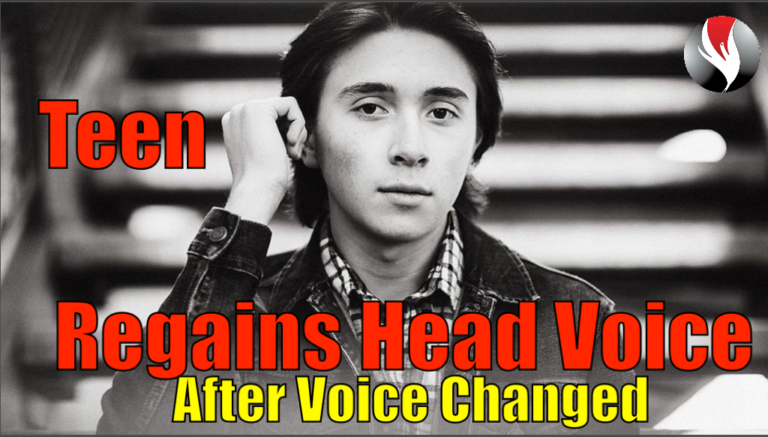Ep.28: How to Sing – Falsetto vs Head Voice?
A common question my students often ask when they’re singing is, “Is that head voice or is that falsetto?”
Inside this video I’ll show you the difference between falsetto and head voice so you’ll know how to sing with both to choose the best for your songs!
Hi, I’m Chuck Gilmore with Power To Sing.
The definitions of falsetto and head voice often disagree. I define them based on the condition of the vocal cords. Are the vocal cords connected or disconnected?
How to Sing in Falsetto
When your vocal cords are disconnected, you are in falsetto. Here’s a slow motion video found on YouTube of the vocal cords disconnecting. This is a scope of voice artist, Mal Webb, from the UK. In this video he’s making some of his unusual vocal sounds. [Video]
You can see and hear the vocal cords suddenly breaking apart. This is falsetto. While in falsetto you can see the edges of the cords are barely touching as they open and close.
With falsetto, a lot of air passes through the cords. [Demoo] Because they’re in falsetto, there’s little to no resistance to the air pressure from the lungs.
You can sing high very easily in falsetto. [Demo] You can also bring the falsetto voice down quite low like this. [Demo] Some singers can bring falsetto all the way down to where you would normally sing in chest voice.
Falsetto will not blend into the chest voice. In order to get back into the chest voice, the vocal cords have to reconnect. This usually involves a break type feeling back into a connection. [Demo]
For men singing in falsetto, there’s a significant loss of the lower overtones of the chest voice. I compare it to my “Minnie Mouse” voice. [Demo] For women, there is a loss of the lower chest overtones in the falsetto voice as well. This can result in a breathy, airy tone quality.
Also, if I try to lean into my falsetto by increasing the volume and air, there is little to no resistance. In fact, it seems to blow the cords further apart. [Demo]
Finally, there is some opinion that years of singing primarily in falsetto is a leading cause of the vocal “wobble” as you get older because the vocal cords have lost their ability to adduct firmly. [Demo]
How Can You Tell if you are in Falsetto and not Head Voice?
How can you tell if you are in falsetto and not head voice when you’re singing on high pitches? If you can descend the scale and sing into your chest voice without reconnecting, then you were in head voice. [Demo]
If you sing down the scale into chest voice and you have to reconnect, you were in falsetto, because falsetto will not blend into chest voice. [Demo]
Some singers can disconnect into falsetto on high pitches. If you can disconnect or flip, then you were in head voice, that is, your cords were connected. I can’t do that after a certain pitch, so that doesn’t work as a test for me on higher notes. It might work for you.
How to Sing in Head Voice
When your vocal cords are connected you are in either chest or head voice. Your lower pitches are your chest voice and the higher pitches are your head voice.
Confusion between falsetto and head voice often occurs when we are singing the higher pitches. This is because on the higher pitches the resonance for both falsetto and head voice vibrates in our heads. [Demo]
The difference is with head voice the resonance is made with connected vocal cords. In contrast, the resonance created by falsetto is made with disconnected vocal cords. Both resonate in the head cavities…but the vocal cords are different. Whether connected or disconnected vocal cords, on higher pitches they both resonate in the same place.
In head voice the vocal cords vibrate in a deeper fashion. That means they’re opening and closing more firmly from bottom to top. This is true even more in chest voice.
In head voice you can control the amount of air that is being resisted by the vocal cords. You can be resisting very little air. [Demo]
Because your vocal cords are connected you can easily add more resistance to air by closing your vocal cords more firmly.
You can learn to sing just as high in head voice as you can in falsetto. But with head voice you can get more intensity. Also present in your head voice are the added chest voice overtones that are absent with falsetto.
Head voice at higher volumes gives your voice a special power, intensity and richness that is difficult to produce with falsetto. [Demo]
Head voice blends smoothly into the chest voice without having to reconnect. There is no clunk into chest voice because the cords did not have to reconnect. [Demo]
Singing in a well balanced head voice will maintain the health and youthfulness of your voice because the vocal cords have maintained their conditioning just like physical exercise promotes good health.
Which is better? Head Voice or Falsetto?
In my opinion, head voice is more useful because it gives the voice more vibrance, control and power. I believe it may be easier to control airflow because the more firmly adducted cords do not allow as much air to escape. Head voice is more useful because it blends into the chest voice smoothly.
The separation of the vocal cords makes falsetto easier to sing high notes and lends itself to song styling.
If you choose falsetto for an occasional style choice I think it’s great.
If you have to sing in falsetto because you can’t sing in head voice, you are limiting yourself as a singer.
Vocal Type Flip-Falsetto
If you flip or break into falsetto as you’re singing through the middle and into your higher notes, or if you sing in falsetto throughout your range, your vocal type is likely flip-falsetto.
Do you know your vocal type? I don’t mean whether you are soprano, alto, tenor or bass. Your vocal type is what you tend to do when you sing. Visit PowerToSing.com and take the vocal test which I call the PowerTest. Take the quiz and discover your vocal type immediately.
Visit the Knowledge Center and learn about your vocal type and download the exercises designed for you. This will help you make progress faster with your voice.
I’m Chuck Gilmore with Power To Sing.
You can sing higher with beauty, confidence and power. I’ll see you inside the next video.
[Watch the whole Video Link for Mal Webb’s vocal cords. It’s very interesting. https://www.youtube.com/watch?v=Q-PZlj0UH0c]









Responses
It takes some time. I recommend focusing on bridging. This will help you get into head voice easier. Try some of these videos: https://le3u30uxng.wpdns.site/knowledge-center/category/first-bridge/
hi, really nicely explained perhaps in simplest possible terms. i am now able to produce head voice only for vowels like you did in this video. but i m still not able to sing in lyrics ,it sounds weak snd feminish.